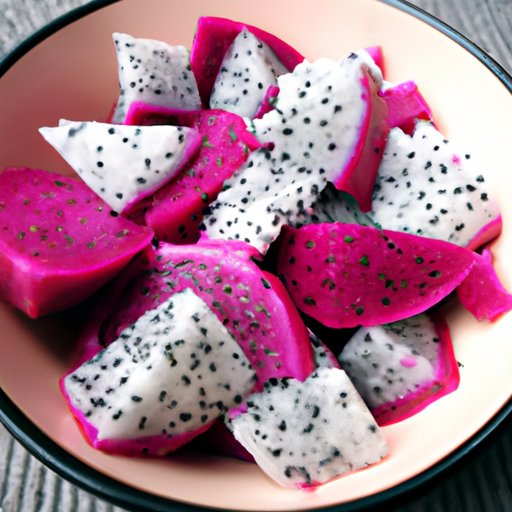
Introduction
Dragon fruit is an exotic fruit that is becoming increasingly popular in Western markets due to its unique appearance, texture, and flavor. However, for many people, this fruit can be intimidating as they are unsure of how to prepare it. This article aims to provide a step-by-step guide to cutting, preparing, and serving dragon fruit, as well as highlighting its nutritional benefits, offering delicious recipes, comparing fresh and freeze-dried varieties, and exploring the cultural significance of the fruit.
How to Cut, Prepare, and Serve Dragon Fruit
Cutting and preparing dragon fruit can be a little daunting, especially if you have never done it before. However, with some simple instructions, it can be quite easy to master.
To start, you will need to identify the variety of dragon fruit you have as there are two types: the white-fleshed and the red-fleshed variety. The white fleshed dragon fruit has a yellow exterior with greenish scales, while the red-fleshed has a bright pink exterior with greenish scales.
When choosing a dragon fruit, you want to ensure that it is ripe, looks shiny, and feels firm to the touch. A ripe dragon fruit should have some give when you press it gently with your fingers. If it is too soft or mushy, it is overripe, and if it’s too hard, it’s not yet ripe.
Once you have your ripe dragon fruit, it is time to prepare it. First, you should wash the fruit under cold water to remove any dirt or debris. Then, you can start cutting it into slices or cubes. To do this, cut off the top and bottom ends of the fruit, keeping it stable on the cutting board. Then, slice the fruit lengthwise in half. You can then use a spoon to scoop out the flesh or cut a few slits into the flesh along the length of the fruit and peel the skin off, like an avocado.
It is worth mentioning that dragon fruit has tiny seeds that are entirely edible. You can choose to eat them or remove them if you prefer.
The Benefits of Eating Dragon Fruit and How to Incorporate it into Your Diet
Dragon fruit is not only delicious but also has many health benefits. One of the most significant advantages is its high nutritional content. It’s packed with vitamin C, vitamin E, antioxidants, and dietary fiber. Additionally, it is low in calories and fat, making it an excellent choice for weight management.
Consuming dragon fruit can contribute to healthy digestion by promoting good bacteria growth in your gut, increasing enzymes that improve your metabolism and aiding in bowel movement. It has been shown that regular consumption of dragon fruit may even offer protection against chronic disease such as heart disease, diabetes or even cancer.
To incorporate dragon fruit into your diet, there are numerous ways in which you can eat it. You can slice the fruit and eat it as it is, add it to your smoothie or juices, toss it into your salads, or even use it as a tropical topping for your bed of yogurt.
Unique and Creative Recipes using Dragon Fruit as a Main Ingredient
Dragon fruit can be used in a variety of dishes, both sweet and savory. It is a versatile fruit that will add vibrancy and texture to your meals.
Here are some innovative and delicious recipes that will incorporate dragon fruit as a main ingredient.
1. Dragon Fruit and Avocado Salad: Combine chopped dragon fruit, avocado, spinach, oranges, and a simple vinaigrette for a refreshing and healthy salad.
2. Dragon Fruit Salsa: Blend chopped dragon fruit, diced tomatoes, red onion, cilantro, and lime juice for a bright and zesty salsa to serve with tortilla chips.
3. Dragon Fruit Smoothie Bowl: Blend dragon fruit, bananas, and coconut milk, then top with granola, fresh berries, and honey for a delicious and nutritious breakfast.
A Comparison between Eating Fresh and Freeze-Dried Dragon Fruit
Freeze-dried dragon fruit is a dehydrated, powdered version of the fruit. The process of freeze-drying extracts most of the water from the fruit while preserving its nutrients, flavor and color.
While fresh dragon fruit offers a unique and juicy texture, freeze-dried dragon fruit can be enjoyed in its dried form. There are pros and cons for both options.
Fresh dragon fruit can limit the frequency of indulgence, due to its seasonality and shelf life, and it’s more expensive to purchase. Freeze-dried dragon fruit can be stored for longer periods without refrigeration and can be added to smoothies, baking or snacks for a concentrated fruit flavor. Although freeze-dried dragon fruit may not offer the same texture, the flavor will still be present, and it will allow you to enjoy the fruit without the perishability of the fresh counterpart.
The Cultural Significance and History of Dragon Fruit and Its Consumption in Various Cuisines
Dragon fruit has long been a part of Asian cuisine and cultures, particularly in Vietnam, where it is a symbol of wealth and prosperity. In China, it is known as pitaya and is considered a symbol of good luck and prosperity.
In addition to its role as a symbol, dragon fruit is often used in dishes and beverages in Vietnamese cuisine. The fruit is commonly used in salads, juices, and smoothies. In China, its usage is more medicinal, known to have several therapeutic effects, it’s commonly used in Chinese traditional medicine.
Conclusion
Dragon fruit is a nutrient-dense and delicious fruit that offers many health benefits. Eating dragon fruit can contribute to a healthy diet and provides versatility in how its consumed. We hope this article has provided you with a step-by-step guide on how to properly cut and serve dragon fruits, some fantastic recipes to try, the variances between fresh and freeze-dried dragon fruit, and the cultural significance of the fruit. Remember, dragon fruit is a delicious fruit that can add color and flavor to any dish.




